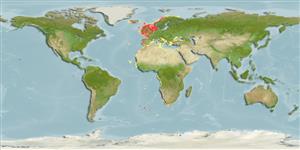Common names from other countries
Environment: milieu / climate zone / depth range / distribution range
Écologie
; saumâtre; profondeur 0 - 200 m (Ref. 435), usually 6 - 40 m (Ref. 435). Temperate, preferred 12°C (Ref. 107945)
Distribution
Pays | Zones FAO | Écosystèmes | Occurrences | Introductions
Eastern Atlantic and the Mediterranean: from northwest Morocco to Atlantic coast of Europe.
Length at first maturity / Taille / Poids / Âge
Maturity: Lm 11.0 range ? - ? cm Max length : 20.0 cm CL mâle / non sexé; (Ref. 435)
This is the most important edible crab fishery in Europe (Ref. 2762). Maximum depth from Ref. 106870. Occurs from the intertidal area to a depth of 100 m, common at depths 6 to 40 m (Ref. 435). Regularly found just above low tide mark. Found in an estuary (Ref. 106870). Inhabits rocky or sandy bottom (Ref. 96377). Carnivore; trophic level 3.1 (Ref. 96418).
Members of the order Decapoda are mostly gonochoric. Mating behavior: Precopulatory courtship ritual is common (through olfactory and tactile cues); usually indirect sperm transfer.
Fischer, W., G. Bianchi and W.B. Scott (eds.). 1981. (Ref. 435)
Statut dans la liste rouge de l'IUCN (Ref. 130435)
statut CITES (Ref. 108899)
Not Evaluated
Not Evaluated
Utilisations par l'homme
Pêcheries: commercial
FAO - pêcheries: landings, species profile | FishSource | Sea Around Us
Outils
Sources Internet
Estimates based on models
Preferred temperature
(Ref.
115969): 8.1 - 12.5, mean 10.4 (based on 518 cells).
Résilience
Haut, temps minimum de doublement de population inférieur à 15 mois (K=0.24-0.46).
Prior r = 0.46, 95% CL = 0.31 - 0.69, Based on 2 data-limited stock assessments.
Vulnérabilité
Low vulnerability (10 of 100).
